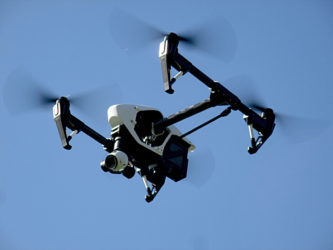The increased use of drones in local airspace will now see operators of the device having to seek permission from the Guyana Civil Aviation Authority (GCAA) beforehand.
This comes as the GCAA moves to regularize the use of such devices for the safety and security of the general public.
Also known as Unmanned Aerial Vehicles (UAV), drones are devices capable of being flown without a pilot on board. They can be flown autonomously by remote control or by the use of onboard computers.

They have recently become popular among photographers here who have used them to capture still and video images of national events. Drones are also currently being used in the Rupununi to monitor the occurrence of deforestation and illegal mining and logging activities in the expansive savannah and surrounding rainforests.
Director General of the GCAA Captain Edgar Fields, in an invited comment, said the decision to implement the new regulations follows an influx of drones recently.
“Persons are really taken with the drone phenomenon… There has been an increase in the commercial use of the drones and we just thought it best to take the necessary steps to have its operation regularized for the safety and security of the general public,” Fields said.
A directive effective from February 27, 2017 prohibits persons from operating UAVs in Guyana’s airspace without first having received written permission from the GCAA. Before such permission is granted, the aviation body has to be furnished with details of the intended operation.
Those seeking permission must present a drawing or reference map indicating the geographical area intended for operation, details of the aircraft to be used including its make, model, serial number and its dimensions.
However, the directive does not apply to the use of UAVs that are seven kilogrammes or less in weight and which are not being used for aerial work or commercial activity, or which do not have the capacity to transmit or receive information other than that required to control the flight of the vehicle.
Therefore, smaller drones without camera or audio features may be operated without permission.
Additionally, the GCAA in its directive said, “No person shall operate an Unmanned Aerial Vehicle, irrespective of the dimensions or maximum weight of that aircraft, for the purposes of obtaining, recording, or transmitting information, whether in the visible spectrum or otherwise, unless that person has obtained written authorization from the Authority to obtain, record, or transmit such information.”
Persons wishing to use the UAV for obtaining, recording, or transmitting information, must submit a request in writing to the GCAA. The request must include the name and address of the applicant and the name of the company he/she is working with, if applicable; a drawing or map reference showing the geographical area over which he/she intends to operate the aircraft; details of the aircraft to be used, including the make, model, serial number and dimensions, as well as the type of power plant installed; the date and time period during which the applicant wishes to operate the aircraft; the purpose for which the information collected will be used; proof that the owner has liability insurance pursuant to the Civil Aviation Regulations currently in force; security clearance for the applicable operation: and any other information requested by the Authority.
Notwithstanding the directive, the GCAA noted that all relevant laws apply to the use of UAVs including the Criminal Law Act, Customs Act and the Telecommunications Act of Guyana.
Just last year, Chaitrani Heeralall, former head of the GCAA had indicated that efforts were being made to regulate the operation of drones and underscored the need for drone operators to be aware of the instrument’s potential hazards when flying in certain zones.
Her concerns at that time, came in wake of a complaint by the Guyana Defence Force (GDF) that one of its helicopters was buzzed by a drone in the vicinity of Thomas Lands, as it was returning to Base Camp Ayanganna in Georgetown. The GDF said that although a serious accident was averted, the drone continued to follow the chopper.
“In what could have been an otherwise tragic occurrence, a Guyana Defence Force helicopter, GDF 1, landed safely without incident at Camp Ayanganna, after it was ‘buzzed’ by what appeared to be a remote-controlled drone, recently,” the army had said in a statement.
“At the time of the incident, the helicopter was making its final approach to Camp Ayanganna, overhead Thomas Lands, in the vicinity of Queen’s College and the National Park. It was reported by the pilot that the drone flew dangerously close to the helicopter and also attempted to follow the aircraft,” the statement added.
For additional information on GCAA’s regulations on the use of drones, persons are encouraged to visit the Guyana Civil Aviation Authority website https://guyanaaviation.com









